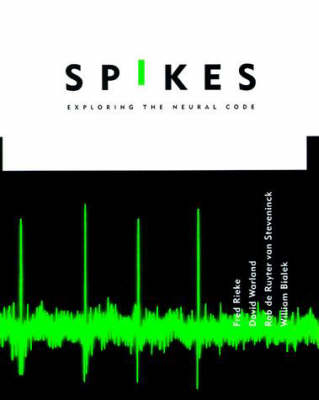
Spikes
Exploring the Neural Code
Seiten
1996
MIT Press (Verlag)
978-0-262-18174-7 (ISBN)
MIT Press (Verlag)
978-0-262-18174-7 (ISBN)
- Titel ist leider vergriffen;
keine Neuauflage - Artikel merken
Intended for neurobiologists with an interest in mathematical analysis of neural data as well as physicists and mathematicians interested in information processing by "real" nervous systems, this text presents a review of relevant concepts in information theory and statistical decision theory.
Our perception of the world is driven by sensory input which is sent to our brains through sequences of spikes carried by sensory neurons, an incoming/outgoing "language of the brain". This book explores the way in which the nervous system represents or encodes these sensory signals, asking in particular whether a linguistic analogy makes sense, whether as in language, there are notions of context that can influence the meaning of the individual words, and whether these questions can be given precise formulations in the design and analysis of experiments on neurons. The authors invite the reader to play the role of a homunculus, a hypothetical observer inside the brain who makes decisions based on the incoming spike trains. This perspective differs from the more traditional ones in two respects: rather than asking how a neuron responds to a given stimulus, the authors ask how the brain could make inferences about an unknown stimulus from a given neural response. The flavour of some problems faced by the organism is captured by analyzing the way in which the observer can make a running reconstruction of the sensory stimulus as it evolves in time.
These ideas are illustrated by examples from experiments on many biological systems. Intended for neurobiologists with an interest in mathematical analysis of neural data as well as the growing number of physicists and mathematicians interested in information processing by "real" nervous systems, "Spikes" provides a self-contained review of relevant concepts in information theory and statistical decision theory. A quantitative framework is used to pose precise questions about the structure of the neural code and these questions in turn influence both the design of experiments and the data analysis.
Our perception of the world is driven by sensory input which is sent to our brains through sequences of spikes carried by sensory neurons, an incoming/outgoing "language of the brain". This book explores the way in which the nervous system represents or encodes these sensory signals, asking in particular whether a linguistic analogy makes sense, whether as in language, there are notions of context that can influence the meaning of the individual words, and whether these questions can be given precise formulations in the design and analysis of experiments on neurons. The authors invite the reader to play the role of a homunculus, a hypothetical observer inside the brain who makes decisions based on the incoming spike trains. This perspective differs from the more traditional ones in two respects: rather than asking how a neuron responds to a given stimulus, the authors ask how the brain could make inferences about an unknown stimulus from a given neural response. The flavour of some problems faced by the organism is captured by analyzing the way in which the observer can make a running reconstruction of the sensory stimulus as it evolves in time.
These ideas are illustrated by examples from experiments on many biological systems. Intended for neurobiologists with an interest in mathematical analysis of neural data as well as the growing number of physicists and mathematicians interested in information processing by "real" nervous systems, "Spikes" provides a self-contained review of relevant concepts in information theory and statistical decision theory. A quantitative framework is used to pose precise questions about the structure of the neural code and these questions in turn influence both the design of experiments and the data analysis.
| Erscheint lt. Verlag | 31.1.1997 |
|---|---|
| Reihe/Serie | Computational Neuroscience |
| Zusatzinfo | 41 |
| Verlagsort | Cambridge, Mass. |
| Sprache | englisch |
| Maße | 185 x 235 mm |
| Gewicht | 839 g |
| Themenwelt | Medizin / Pharmazie ► Medizinische Fachgebiete ► Neurologie |
| Naturwissenschaften ► Biologie ► Humanbiologie | |
| Naturwissenschaften ► Biologie ► Zoologie | |
| Naturwissenschaften ► Physik / Astronomie ► Angewandte Physik | |
| ISBN-10 | 0-262-18174-6 / 0262181746 |
| ISBN-13 | 978-0-262-18174-7 / 9780262181747 |
| Zustand | Neuware |
| Haben Sie eine Frage zum Produkt? |
Mehr entdecken
aus dem Bereich
aus dem Bereich
Buch | Hardcover (2012)
Westermann Schulbuchverlag
CHF 44,90
Schulbuch Klassen 7/8 (G9)
Buch | Hardcover (2015)
Klett (Verlag)
CHF 29,90
Buch | Softcover (2004)
Cornelsen Verlag
CHF 23,90


